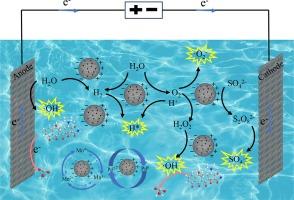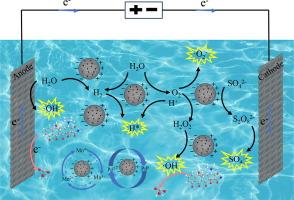Electrocatalysis degradation of tetracycline in a three-dimensional electrocatalysis reactor (3DER) with MnO2/Pd(OAC)2@CA particle electrodes: Influencing factors, degradation pathway and toxicity assessment
IF 9
1区 工程技术
Q1 ENGINEERING, CHEMICAL
引用次数: 0
Abstract
The extensive use of antibiotics poses a significant risk to human health, and electrocatalysis has demonstrated effectiveness in treating antibiotic contamination. This study details the synthesis of MnO2/Pd(OAC)2@CA particle electrodes using a straightforward one-step sol–gel method and the development of a three-dimensional electrocatalytic reactor (3DER) to remove antibiotics from water. Under optimal conditions (1.5 g/L MnO2/0.3%Pd(OAC)2, pH 3 and 2.0 V), a degradation of 97.8% of tetracycline hydrochloride (TCH) at a concentration of 15 mg/L is achieved within 80 min. The rate constant in the 3DER (k = 0.0389) is 9.26 times greater than that in a two-dimensional electrocatalytic reactor (2DER) (k = 0.0043). After ten cycles of treatment, the degradation rate of TCH remains at 86.4%. Furthermore, under optimal conditions, the energy consumption of the 3DER is significantly lower than that reported in other studies, with an EEO value of only 0.033 kWh/m3. Radical scavenger experiments and electron paramagnetic resonance (EPR) studies identify the free radicals involved, including •OH, SO4•–, H*, and •O2–. Theoretical calculations and toxicity assessment reveal a general reduction in the toxicity of the intermediate products formed during the electrocatalytic degradation of TCH. In summary, the MnO2/Pd(OAC)2@CA particle electrodes exhibit high electrocatalytic degradation efficiency, excellent recyclability and reusability. The 3DER constructed using particle electrodes demonstrates broad applicability and environmental friendliness, providing a novel solution for remediating antibiotic-contaminated water.


MnO2/Pd(OAC)2@CA颗粒电极在三维电催化反应器(3DER)中电催化降解四环素:影响因素、降解途径及毒性评价
抗生素的广泛使用对人类健康构成重大风险,电催化已证明在处理抗生素污染方面是有效的。本研究详细介绍了采用简单的一步溶胶-凝胶法合成MnO2/Pd(OAC)2@CA颗粒电极,并开发了用于去除水中抗生素的三维电催化反应器(3DER)。在最佳条件(1.5 g/L MnO2/0.3 %Pd(OAC)2, pH 3和2.0 V)下,在浓度为15 mg/L时,在80 min内可降解97.8% %的盐酸四环素(TCH)。三维电催化反应器(k = 0.0389)的速率常数比二维电催化反应器(k = 0.0043)的速率常数大9.26倍。经过10个循环处理,TCH的降解率保持在86.4 %。此外,在最优条件下,3DER的能耗显著低于其他研究报告,其EEO值仅为0.033 kWh/m3。自由基清除剂实验和电子顺磁共振(EPR)研究确定了涉及的自由基,包括•OH, SO4•-,H*和•O2 -。理论计算和毒性评估表明,在电催化降解TCH过程中形成的中间产物的毒性普遍降低。综上所述,MnO2/Pd(OAC)2@CA颗粒电极具有较高的电催化降解效率、良好的可回收性和可重复使用性。使用颗粒电极构建的3DER具有广泛的适用性和环境友好性,为修复抗生素污染的水提供了一种新的解决方案。
本文章由计算机程序翻译,如有差异,请以英文原文为准。
求助全文
约1分钟内获得全文
求助全文
来源期刊

Separation and Purification Technology
工程技术-工程:化工
CiteScore
14.00
自引率
12.80%
发文量
2347
审稿时长
43 days
期刊介绍:
Separation and Purification Technology is a premier journal committed to sharing innovative methods for separation and purification in chemical and environmental engineering, encompassing both homogeneous solutions and heterogeneous mixtures. Our scope includes the separation and/or purification of liquids, vapors, and gases, as well as carbon capture and separation techniques. However, it's important to note that methods solely intended for analytical purposes are not within the scope of the journal. Additionally, disciplines such as soil science, polymer science, and metallurgy fall outside the purview of Separation and Purification Technology. Join us in advancing the field of separation and purification methods for sustainable solutions in chemical and environmental engineering.
文献相关原料
公司名称
产品信息
阿拉丁
sodium alginate
 求助内容:
求助内容: 应助结果提醒方式:
应助结果提醒方式:


